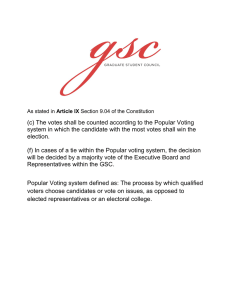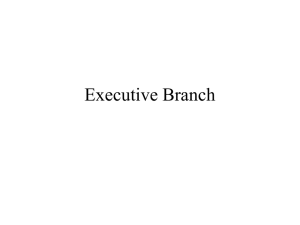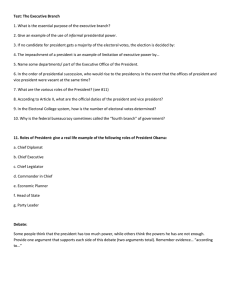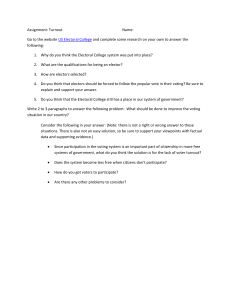Welcome Everyone! These are the notes used by the presenters... for “Does My Vote Count” on October 22
advertisement
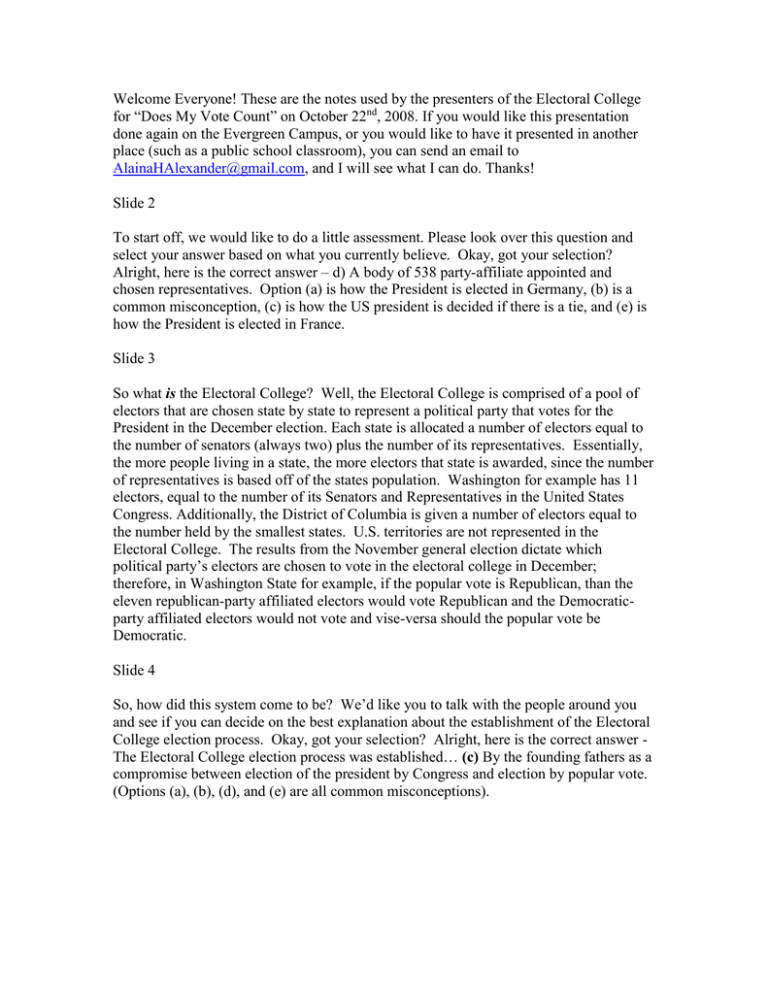
Welcome Everyone! These are the notes used by the presenters of the Electoral College for “Does My Vote Count” on October 22nd, 2008. If you would like this presentation done again on the Evergreen Campus, or you would like to have it presented in another place (such as a public school classroom), you can send an email to AlainaHAlexander@gmail.com, and I will see what I can do. Thanks! Slide 2 To start off, we would like to do a little assessment. Please look over this question and select your answer based on what you currently believe. Okay, got your selection? Alright, here is the correct answer – d) A body of 538 party-affiliate appointed and chosen representatives. Option (a) is how the President is elected in Germany, (b) is a common misconception, (c) is how the US president is decided if there is a tie, and (e) is how the President is elected in France. Slide 3 So what is the Electoral College? Well, the Electoral College is comprised of a pool of electors that are chosen state by state to represent a political party that votes for the President in the December election. Each state is allocated a number of electors equal to the number of senators (always two) plus the number of its representatives. Essentially, the more people living in a state, the more electors that state is awarded, since the number of representatives is based off of the states population. Washington for example has 11 electors, equal to the number of its Senators and Representatives in the United States Congress. Additionally, the District of Columbia is given a number of electors equal to the number held by the smallest states. U.S. territories are not represented in the Electoral College. The results from the November general election dictate which political party’s electors are chosen to vote in the electoral college in December; therefore, in Washington State for example, if the popular vote is Republican, than the eleven republican-party affiliated electors would vote Republican and the Democraticparty affiliated electors would not vote and vise-versa should the popular vote be Democratic. Slide 4 So, how did this system come to be? We’d like you to talk with the people around you and see if you can decide on the best explanation about the establishment of the Electoral College election process. Okay, got your selection? Alright, here is the correct answer The Electoral College election process was established… (c) By the founding fathers as a compromise between election of the president by Congress and election by popular vote. (Options (a), (b), (d), and (e) are all common misconceptions). Slide 5 Thomas Jefferson constructed the first of the five so-called divisor methods, which involve searching for a number that is close to the average district size (national population divided by number of representatives) but satisfies a certain specified numerical property and therefore makes apportionment possible. Jefferson’s Method was to find a divisor, X, that had the following property: If you divide each state’s population by X and round down to the next lowest whole number, then sum the result across all the states, your result is equal to the House size. President George Washington decided to use Jefferson’s method, however it was overturned after the method’s large-state bias had become apparent. Jefferson’s method was adopted in 1792 and dropped in 1842. Alexander Hamilton’s method was then pushed to the forefront; Divide each state’s population by the national population, then multiply by the number of seats in the House. That is each state’s share, or quota. Give each state the highest whole number below its quota, or one, whichever is greater. If there are X seats remaining, assign one seat to the X states with the highest fractional remainder. The only problem with this method was that it produced a paradox: Increase the overall size of the House, and some states can lose seats. Hamilton’s method was adopted in 1852 and dropped in 1901. Daniel Webster said the best process would emerge as a “matter of mathematical certainty”. His method was to find the divisor, X, that has the following property: If you divide each state’s population by X and round up or down to the nearest whole number, then sum the result across all the states, your result is equal to the House size. This was largely adopted in 1901 and lasted until 1941. Lastly is the Hill method put forth by Joseph A. Hill. This method was adopted in 1941 and is still used today; find the divisor, X, that has the following property: If you divide each state’s population by X and round to the nearest whole number by geometric mean, then sum the result across all the states, your result is equal to the House size. Slide 6 So how does the process of electing our president work? Well, first we have the governmentally-run local primaries which essentially is an election in which voters select candidates for the subsequent election, or, in other words, a means by which a political party nominates candidates for the general election. States may also choose to select a presidential nominee by way of a caucus, a meeting of members of a political party to coordinate members’ actions, choose group policy, or nominate candidates for various offices. Each state has their own decided type of primary and/or caucus: closed, open, and semi-open – Washington Sate currently has an open primary and caucus. Depending on state law and state party rules, when voters cast ballots for a candidate in the primary or caucus, they may actually be voting to award delegates (a person elected to the House of Representatives). These delegates are “bound” to vote for a presidential candidate at the national convention. Once both major political parties officially nominate their candidate for President at their respective national conventions, the next step is the general election held on Election Day (the Tuesday after the first Monday in November). During the months prior to Election Day, candidates for electors are nominated and chosen through primaries, party conventions, or campaign committees. These electors pledge to vote for the Presidential and Vice Presidential ticket that wins the state’s popular vote; however, these electors are not bound by federal law to vote for the party that they pledged to vote for. After the general election, the state’s popular vote for the Presidential and Vice Presidential ticket is then decided; whichever major political party ticket won the popular vote for the state, the pledged party-affiliated electors will then cast electoral votes for that ticket. A Presidential candidate must receive an absolute majority of electoral votes (currently 270) to win the Presidency. Slide 7 Electors are chosen usually as a reward for many years of service to their party; they may be State elected officials, party leaders, or persons who have a personal or political affiliation with the Presidential candidate. The two most common ways that electors are chosen is by nomination by their state party committee or by campaigning for the position then voted for during the state’s party convention. Electors cannot be a Representative or Senator, they cannot be a high-ranking U.S. official in a position of “trust or profit”, and they cannot be someone who has “engaged in insurrection or rebellion” against the U.S. These electors represent a “diverse” America; they are housewives, lawyers, activists, and most any other career that does not include holding a federal office. Slide 8 The process of electing the president is essentially divided into four stages: 1] The pre-nomination phase, in which candidates compete in state primary elections and caucuses for delegates to the national party conventions; 2] the national conventions, held in the summer of the election year in which the two major parties nominate candidates for president and vice president and ratify a platform for the party’s policy, positions and goals; 3] the general election campaign, in which the major party nominees, as well as any minor party or independent contenders, compete for votes from the entire electorate, culminating in the popular vote on election November; 4] The Electoral College phase, in which the president and vice president are officially elected via the votes cast by each state’s electors. Slide 9 In our next few slides, we have chosen to show representational data based on the 2000 election. The reasons we decided to highlight the 2000 election are the following: the year 2000 contains the most recent data and statistics from the US census (which takes place every ten years), pivotal. The 2000 election was very controversial due to the fact that for the first time in 100 years, the candidate that won did not have the national popular vote. President George W. Bush won the election with 271 electoral votes compared to Al Gore’s 266 electoral votes, even though Gore had a 543,816 popular vote lead. This shocking fact lead to a sparked interest in the Electoral College and how it functions and whether or not the system is just and fair. One of the two main problems people found with the electoral college was the fact that during the 2000 election, there was one faithless elector who abstained from the official tally; the other issue was the Green Party Candidate, Ralph Nader, who many people felt took votes away from Gore as exit polls show that 47% of Nader voters would have voted for Gore (vs. the 21% that would have voted for Bush) if the race had been between just the two. Lastly, there was a large issue over Florida’s votes. Florida was the major swing state in the 2000 election, holding 25 electoral votes, which, mathematically, was the key to winning the election. After all votes were counted, Gore was lagging behind Bush by just over 2000 votes. News networks retracted their predictions that Bush had won Florida and the presidency, quickly followed by the withdrawal of Gore’s concession. Gore announced that he would wait for a recount in Florida before any further action. After the first recount, Bush's margin in Florida had dwindled to about 500 votes, narrow enough to trigger a mandatory recount for the state. In addition, Gore asked for hand recounts in four counties (Broward, Miami Dade, Palm Beach, and Volusia), as provided under Florida state law. This set into motion a series of recounts (portions by machine, and portions by hand), questions about portions of the Florida vote, and finally lawsuits. Slide 10 This shows US population density from the 2000 census. The white spots represent areas of dense population. Slide 11 This slide shows a map of the US with a county-by-county breakdown of voter partisanship from the 2000 election. The more blue a county is, the more democratic leaning they are, the more red they are, the more republican leaning they are. A purple county means that there was an approximately 50/50 split (of those voting democrat or repuiblican) Slide 12 This is the screenshot from the website 270towin.com from the 2000 election. This site shows a state-by-state picture of democrat and republican leanings (based on the most current polls). The information here changes day by day based on up to the minute polls, so check it out today for the 2008 election! Slide 13 This is putting together information from slide 11 and 12 to show how the different regions in the US voted in the 2000 election. Slide 14 Here is a list of each of the states and how many electoral votes they currently have. Slide 15 Apportionment, or the number of electors each state is provided, has some major flaws in the determining of it. As stated earlier each state is allocated a number of electors equal to the number of senators (always two) plus the number of its representatives. Since the number of representatives is based on the state’s population, the more people living in a state, the more electors that state is awarded. However, the population number that decides the number of representatives includes those who cannot vote, such as illegal immigrants and minors. Therefore a state may have more electors based on the state’s population, but the actual amount of people who can vote may be significantly less. On the flipside, overseas citizens such as military, missionaries, and students studying abroad, are excluded entirely from the census count relevant to the constitutional purpose of apportioning representation in the House of Representatives. In the last two censuses, a subset of the overseas population was enumerated but only for those who happened to be employed by the federal government. Therefore a state may have less electors based on the state’s domestic population, but could possibly be awarded more electors if overseas citizens were accounted for in the state’s population. Another downfall of apportionment is that the U.S. census bureau only updates the population totals once every ten years. Since one term for presidency is four years, two presidential elections will be electorally voted for based on dated population size. And with population constantly changing, this could make a significant difference in the number of representatives and electors awarded to a state within those ten years. And lastly one other area of contention is the cap on the number of seats in the House of Representatives, which is currently set at a total of 440 seats; made up of 435 voting representatives and 5 non-voting representatives. During the period that the current U.S. Constitution has been in effect, the number of citizens per congressional district has risen from an average of 30,000 in 1789 to nearly 700,000 as of 2008. Many feel that a new reapportionment act is needed to significantly raise the number of representatives to create more equitable districts. Slide 16 Voter turnout for presidential elections has been declining in recent years, although the 2004 election showed a noticeable increase over the turnout in 1996 and 2000. While voter turnout has been decreasing, voter registration has been increasing. Registration rates varied from 65% to 70% of the voting age population from the 1960s to the 1980s, and due in part to greater government outreach programs, registration swelled to 75% in 1996 and 2000. Despite greater registration, however, turnout in general has not greatly improved. It should be noted that the voting age population includes all persons age 18 and over as reported by the U.S. Census Bureau, which necessarily includes a significant number of persons ineligible to vote, such as non-citizens, felons, and the mentally incompetent. The actual number of eligible voters is somewhat lower, and the number of registered voters is lower still. The number of non-citizens in 1994 was approximately 13 million, and in 1996, felons numbered around 1.3 million, so it can be estimated that around 710% of the voting age population is ineligible to vote. Slide 18 With all of the information we have given you, some of you may be wondering why the Electoral College is still in place. What are the benefits of the Electoral College? For the most part the Electoral College has produced non-controversial presidential results. The Electoral College also promotes an ideologically two-party system, where, without the college, the U.S. election process would begin to take on a different and more difficult turn where many small parties would compete and gain recognition because they would get a portion of the vote. The Electoral College also acts as a sort of administrative intermediary that keeps some of the power in the states. Without the Electoral College there would be lesser role of the states and enhancement of the role of the federal government. The Electoral College reflects the role of the states in our system of dual sovereignty between the state and federal governments. The founders chose to divide government that way so that no one power would be dominant. If the college were abolished, presidential candidates would campaign almost exclusively in major population centers to capture efficiently the broadest number of votes. The Electoral College also enhances the status of minority interest since there is a blanket number of electors that cover the state’s population, including the large amount of minorities that may reside in that state. And lastly, the electoral college helps emphasize a federalist government in which a group of members are brought together with a representative head; in this case the group of members being the U.S. party-affiliated citizens and the head being the electors. Slide 19 However, there are also many arguments as to why the electoral college does not work and why it should be reformed or cease to be. The main contention is the possibility of a president being elected by winning the electoral votes but not the national popular vote, as most recently seen in the 2000 election year. Many feel that this is not a form of democracy, since the unanimous ideal is that the presidency should be chosen by the people. There is also the risk of so-called “faithless electors”. Electors are not mandated by law to vote for the candidate they pledge to vote for and therefore may vote for another candidate or abstain from voting. In total, there have been 8 faithless electors since the beginning of the Electoral College, the most recent seen in the 2000 election when one elector abstained from voting. Another concern is the risk of depressing voter turnout since each state is entitled to a set number of electoral votes regardless of its voter turnout; so many feel there is no incentive in the states to encourage voter participation. Finally, the last major point of contention is the Electoral College’s failure to accurately reflect the national popular will, due to over-representation of rural States and underrepresentation in more populated states. For example, a vote in Wyoming (a state with only three electoral votes) counts almost triple the amount as a vote in California (which has 55 electoral votes). The “winner-take-all” position of the states adds to the inaccurately reflected popular will since the popular vote for the state gives that candidate all the state’s electoral votes. Slide 20 Proposals made to Change the System: Over the past 200 years since the Electoral College has been in effect, there have been over 700 proposals introduced in Congress to change or eliminate the Electoral College. There have been more proposals for Constitutional amendments on changing the Electoral College than on any other subject. Public opinion polls have shown Americans favored abolishing the system. Several joint resolutions were introduced in the current Congress and were referred to the Committee on the Judiciary. The proposals, all introduced in the House of Representatives, include the following: Voting rights for residents of the United States territories and commonwealths, Direct election of the President and Vice President by the popular cote, Right to vote amendment, and Every Vote Counts amendment. Voting rights for residents of the United States territories and commonwealths: This amendment was proposed on January 4th, 2007, and proposes that the right of citizens of the United States to vote in the election for President and Vice President shall not be denied or abridged by the United States or by any State on account of residency in a territory or commonwealth of the United States. Direct election of the President and Vice President by the popular vote: This amendment was proposed on February 13th, 2007, and proposes that the President and Vice President shall be elected jointly by the direct vote of the citizens of the United States, without regard to whether the citizens are residents of a State and that the persons having the greatest number of votes for President and Vice President shall be elected, so long as such persons have a majority of the votes cast. Right to Vote amendment: This amendment was proposed on February 13th, 2007, and proposes that all citizens of the United States who are eighteen years of age or older shall have the right to vote in any public election held in the jurisdiction in which the citizen resides. The right to vote shall not be denied or abridged by the United States, any State, or any other public or private person or entity, except that the United States or any State may establish regulations narrowly tailored to produce efficient and honest elections. It also proposes that each State shall administer public elections in the State in accordance with election performance standards established by the Congress. The Congress shall reconsider such election performance standards at least once every four years to determine if higher standards should be established to reflect improvements in methods and practices regarding the administration of elections. And lastly it proposes that each State shall provide any eligible voter the opportunity to register and vote on the day of any public election. Every Vote Counts amendment: This amendment was proposed on January 4th, 2007, and proposes that the President and Vice President shall be elected by the people of the several States and the district constituting the seat of government of the United States. It goes on to propose that the electors in each State shall have the qualifications requisite for electors of Senators and Representatives in Congress from that State, except that the legislature of any State may prescribe less restrictive qualifications with respect to residence and Congress may establish uniform residence and age qualifications. It proposes that the persons having the greatest number of votes for President and Vice President shall be elected and that each elector shall cast a single vote jointly applicable to President and Vice President. Names of candidates may not be joined unless they shall have consented thereto and no candidate may consent to the candidate's name being joined with that of more than one other person. It also proposes that the Congress may by law provide for the case of the death of any candidate for President or Vice President before the day on which the President-elect or Vice President-elect has been chosen, and for the case of a tie in any election. Slide 21 Alternative Systems: Alternative systems and reform options to the Electoral College have been proposed. First, there is the Direct Election with Instant Runoff Voting. Instant runoff voting could be used for Presidential elections with or without the Electoral College. With a direct vote, voters would rank their preferences rather than marking only one candidate. Then, when the votes are counted, if no single candidate has a majority, the candidate with the lowest number of votes is eliminated. The ballots are then counted again, this time tallying the second choice votes from those ballots indicating the eliminated candidate as the first choice. The process is repeated until a candidate receives a majority, reducing time and money wasted in a normal runoff election. Second, there is the Proportional Allocation of Electoral Votes. This system has been proposed with a number of variations. As a popular alternative, it splits each state’s electoral votes in accordance with their popular vote percentages. This way, a candidate who comes in second place in a state with 45% of the popular vote would receive 45% of the electoral votes from that state, instead of 0%. This system would greatly increase voter turnout and the representation of all parties in a state. It would also encourage candidates to campaign in all states rather than just those that are competitive. Though the majority, as always, would come out on top in each state, the minority's supporters would not be effectively contributing to their candidate's defeat when the whole of their state's electoral votes go a candidate they do not support. Third, there is the Direct Cote with Plurality Rule. This method would abolish the Electoral College and require each person to cast one vote for the candidate of their choice. The candidate who receives the most votes nationwide would win the election, with or without a majority of the votes. This option would require a constitutional amendment to be implemented and would therefore need the support of 2/3 of Congress and 3/4 of the states. This method of voting would more accurately reflect the popular will of the nation at large. Statistics have shown that more people vote when they know that their vote has a better chance at making a difference. Fourth, the Congressional District Method. This method divides electoral votes by district, allocating one vote to each district and using the remaining two as a bonus for the statewide popular vote winner. This method of distribution has been used in Maine since 1972 and Nebraska since 1996, though neither state has had a statewide winner that has not swept all of the Congressional districts as well. Consequently, neither state has ever spilt its electoral votes. Fifth, is the National Bonus Plan. This idea, proposed by historian Arthur Schlesinger Jr., retains the current Electoral College system, but also awards extra electoral votes as a bonus to the winner of the popular vote. The amount suggested by Schlesinger in his National Bonus Plan is 102 extra electoral votes (two for every state and two for Washington, DC). The extra boost of electoral votes would almost always be able to guarantee that the popular vote winner would also be the Electoral College winner. While technically maintaining the institution, this option compensates for the uneven power given to the states by the Electoral College. This method would encourage people to campaign and vote in non-competitive states in an attempt to win the popular vote. And lastly, there is the Binding Proposal. Professor and author, Judith A. Best also has proposed to amend the Constitution, although in a drastically different way than those we have explored so far. Best would like to amend the Constitution to bind all electors federally, meaning that they would be forced to vote based on their party pledge if their party's nominee wins their state. Her amendment would also solidify the winner-take-all unit rule into the Constitution. Slide 22 This is the screenshot from the site 270towin.com from October 22nd, 2008. Check this site out for the most up-to-date poll results state by state, as well as predictions for the 2008 election. Slide 23 Please share this information with your friends. Show them this presentation, or just give them a few interesting facts about our system that you think they need to know. Thanks for spreading the word!

